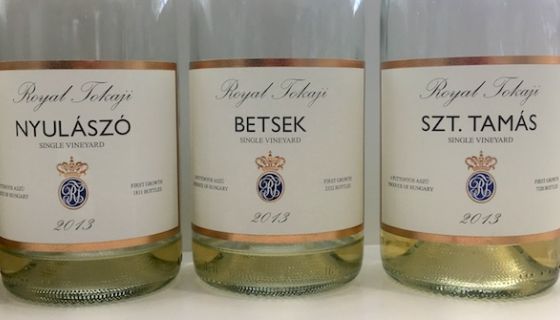- Blue Label from 5,550 Hungarian forint, 92 Romanian leu, £21, 284.90 Norwegian kroner, €29.90, CA$48.75, $41.95, HK$55, 2,394 New Taiwan dollars, 256 Brazilian reais
- Gold label from 9,000 Hungarian forint, £37.81, €49.90, $69.99, 2,700 New Taiwan dollars, 504.72 Brazilian reais
- Single vineyards from 18,290 Hungarian forint
Find the Blue Label 5 Puttonyos
Find the Gold Label 6 Puttonyos
Find the Nyulászó, Betsek and Szt Tamás
It seems that some people just won't listen to reason – attendees at the recent Flat Earth International Conference being a prime example. Yet we wine lovers, normally such reasonable and reasoned people, can be equally guilty of ignoring the evidence that's right in front of us. We've all heard that great sweet wines belong among the pantheon of the most divine bottles, yet how often do we buy them and drink them? (See also Please try more sweet wines for Jancis's plea from 2016.)
Let this be the moment, then, because the 2013 Aszú vintages (see below for an explanation of Aszú) from Royal Tokaji are indeed God-like in their greatness.
This September, I tasted five of their top cuvées as part of a retrospective tasting going back to their first vintage in 1990 (write-up coming soon) which gave a forcible reminder of how essential these wines are. Essential because they are downright delicious, first and foremost – but essential also because they are documents of a most particular winemaking practice and heritage, and furthermore because they represent a region (and its native varieties) which need our support.
The region is Tokaj, of course – and you can read more about its grapes, winemaking and history in the Oxford Companion entry and any of these articles. Otherwise, all we need remember is that Aszú indicates the traditional practice of adding hand-selected shrivelled and nobly rotten berries to the fermentation; that puttonyos is a numerical indication of sweetness, where six is sweeter than five; and that the earth is round, dammit.
But what I really want to talk about is the wines themselves.
We tasted five 2013s: two blends and three from single vineyards, and I recommend them all unreservedly. Choosing which to buy is less a matter of outright quality than it is budget and style preference.
The two blends are known as blue and gold label, as illustrated below. The former is classified as five puttonyos, with 162 grams per litre of sugar, while the latter is six puttonyos and 188 g/l. That difference in sweetness is barely perceptible on the palate, nor are there significant differences between the complexity and intensity of each. Flavours range from apple to peach to pear, with the caramel and honey richness of great dessert wines, as well as floral and spice aromas – they pretty much deliver the whole flavour wheel of complexity.

The main difference between them is that the gold label has more weight and persistence on the palate – which doubtless accounts for its lower production volumes (and therefore higher price). It may well have greater potential longevity in bottle, but there is no need to wait before opening either of these 2013s – the elixir of their youth is exactly what makes them so compelling to drink now.
The three single-vineyard wines all come from first growths around the village of Mád, from an original classification which dates back to the 1700s. All south facing, Betsek has dark clay soils, Nyulászó has browner clay, while Szt Tamás has red clay rich in volcanic minerals. They are all six puttonyos, and range between 172 and 182 grams of sugar per litre.
But such functional description does them no justice! To taste these wines is to experience a level of intensity and aromatic profundity which is simply thrilling. The Betsek was the least fantastic of the three, for me, but even so I scored it 18 out of 20. And if you need any more convincing, here is Royal Tokaji's own assesment of the vintage:
'It is obvious that 2013 is among top vintages for Royal Tokaji regarding the quality of both dry and sweet wines, especially Aszú, as already predicted by the grapes' large berry size and their thin skin by the middle of July. It had been several years since such a top vintage for botrytis and Aszú, but it was well worth the wait – only time will tell if 2013 proves to be one of the all-time greats, but it is certainly exceptional and has produced brilliant Royal Tokaji Aszú wines.'
Amen to that. I heartily recommend them as an ideal accompaniment to any festive feast, or indeed as a great gift for any wine lover, but as sure as the earth is round, these remarkable Tokaji Aszú 2013s truly should be wines for all seasons.
Find the Blue Label 5 Puttonyos
Find the Gold Label 6 Puttonyos
Find the Nyulászó, Betsek and Szt Tamás














